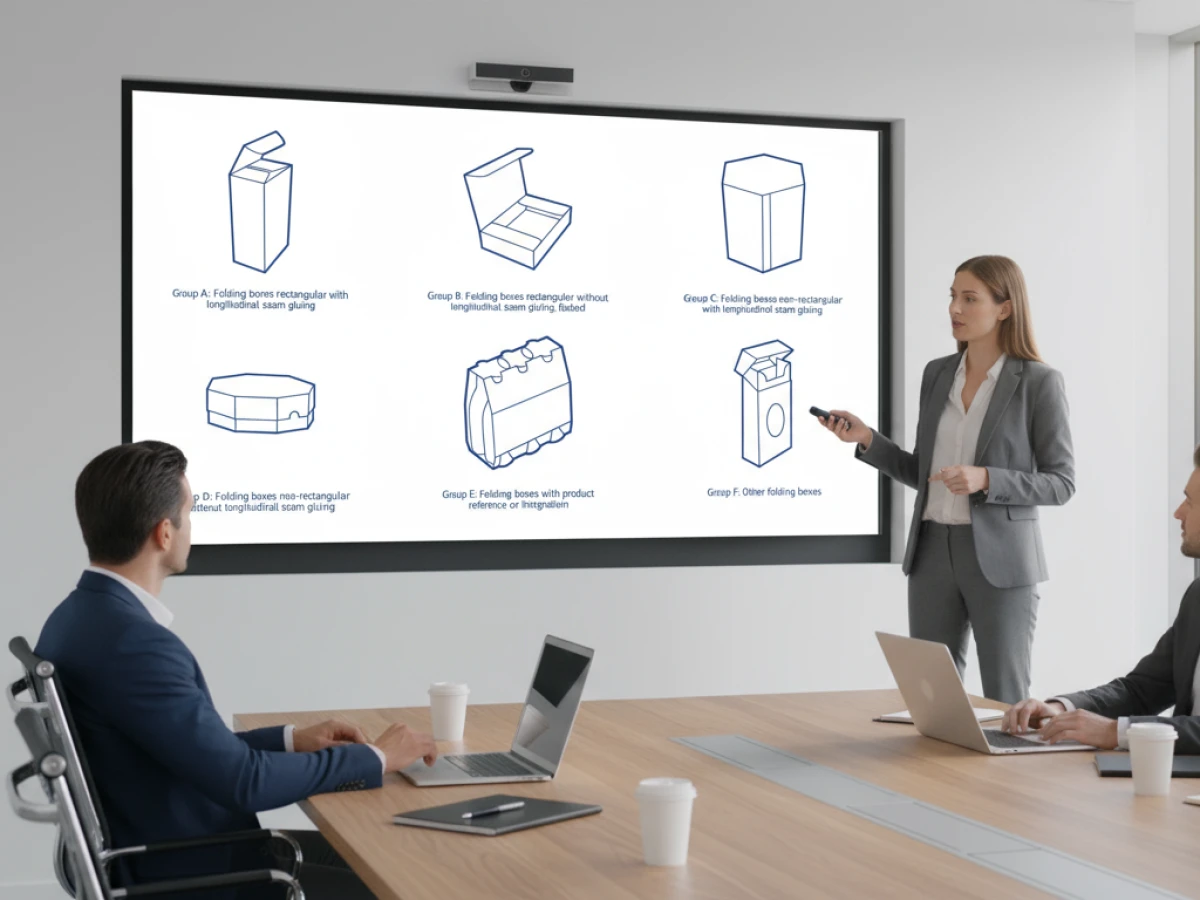ECMA & FEFCO Box Library – Packaging Standards Meet Web-to-Pack Innovation
.webp)
The ECMA & FEFCO Box Library is one of PackQ’s most powerful features—bridging traditional packaging standards with digital automation. It integrates over 400 standardized box models directly into the online design process, allowing users to configure folding cartons and corrugated boxes without CAD expertise. By embedding these international codes, PackQ ensures that every online configuration is technically sound, production-ready, and globally understood. This article dives deep into how the ECMA and FEFCO standards work, why they matter, and how PackQ uses them to streamline packaging development across industries.
Why Standards Matter in a Digital Packaging World
Packaging design has always been a dance between creativity and precision. While designers think in terms of aesthetics, materials, and brand identity, engineers and converters care about folding angles, glue flaps, and machine compatibility. For decades, two global standards have bridged this gap: ECMA (for folding cartons) and FEFCO (for corrugated boxes).
packQ’s ECMA & FEFCO Box Library transforms these time-tested standards into living digital templates. It lets anyone—from packaging engineers to marketing teams—configure boxes online with complete production accuracy, without ever touching CAD software.
This integration is not just about convenience—it’s about automation, scalability, and quality assurance. In Web-to-Pack, where hundreds of small orders and short runs are processed every day, standardized templates are the foundation of efficiency.
1. Understanding ECMA and FEFCO: The DNA of Box Design
ECMA – The Folding Carton Standard
The European Carton Makers Association (ECMA) was founded in 1960 to bring uniformity to the folding carton industry. Its ECMA Code system classifies hundreds of carton types using a simple alphanumeric scheme (A, B, E series, etc.).
Each ECMA code corresponds to a specific box structure—complete with predefined panel layout, flap styles, and closure mechanisms. For example:
- ECMA A-series: Rectangular folding boxes
- ECMA B-series: Tube-style cartons
- ECMA E-series: Slipcases and sleeves
- ECMA F-series: Multi-part constructions
By referring to a code like ECMA A4321, engineers and printers instantly know what structural geometry is expected—no lengthy descriptions or ambiguous sketches.
This common language eliminates misunderstandings between design, production, and procurement. Today, ECMA designs dominate more than 70 % of the global folding carton market and form the basis of most automated packaging workflows.
FEFCO – The Corrugated Box Standard
The Fédération Européenne des Fabricants de Carton Ondulé (FEFCO)—the European Federation of Corrugated Board Manufacturers—introduced its own system in 1952.
The FEFCO Code catalog defines around 200 structural types for corrugated and solid board packaging, each identified by a four-digit number (e.g. FEFCO 0201, 0427, 0713).
2. Why packQ Integrates ECMA and FEFCO Standards
packQ’s philosophy is automation through standardization. In the world of Web-to-Pack, efficiency comes from predictable, parameter-driven templates that remove guesswork from structural design.
By embedding the ECMA and FEFCO codes directly into its 3D designer and backend logic, packQ provides:
- Immediate structural reliability: Every design is based on a proven construction pattern.
- Parametric flexibility: Dimensions, materials, and closures are adjustable—while maintaining structural integrity.
- CAD-grade precision: The system automatically generates die-cut outlines (DXF/PDF) compliant with the chosen standard.
- Workflow compatibility: Production data (e.g. cutting lines, creases, glue flaps) match existing tooling databases.
- End-user simplicity: Non-experts can design technically correct boxes just by adjusting width, height, and depth sliders.
In short: ECMA and FEFCO are the grammar and syntax of packaging. packQ speaks this language fluently.
.webp)
3. How the ECMA & FEFCO Library Works in packQ
3.1 Parameterized Templates
Every ECMA or FEFCO model inside packQ is stored as a parametric geometry—a digital blueprint that can adapt to user inputs.
When a customer enters custom dimensions, packQ recalculates fold lines, flap proportions, and glue areas automatically. The resulting dieline remains fully compliant with the original code, simply scaled or stretched within permissible tolerances.
3.2 Real-Time Visualization
packQ links the parametric backend with its 3D Packaging Designer. That means when a user selects “FEFCO 0201” and modifies dimensions, the 3D preview updates instantly. Artwork, creases, and textures remap in real time, giving a true what-you-see-is-what-you-get experience.
3.3 Automatic CAD Output
Upon configuration, packQ’s CAD engine generates:
- Flattened cutting patterns (PDF, DXF)
- 3D models (OBJ, GLB) for visualization or AR
- Embedded metadata indicating ECMA/FEFCO code, dimensions, and materials
These files can go directly to cutting tables, digital presses, or MIS systems—no manual intervention required.
3.4 Intelligent Constraints
To maintain structural validity, packQ enforces predefined parameter boundaries (e.g. minimum flap widths, safe aspect ratios). If a user enters an invalid value, the system automatically corrects or warns them. This ensures that all resulting dielines remain machine-compatible and production-safe.
3.5 Integration with Pricing & Production
Each template carries linked cost parameters—material usage, sheet layout efficiency, gluing or cutting complexity—which feed into packQ’s dynamic pricing engine.
When the user adjusts the box size or type, the price recalculates in real time, reflecting actual production costs.
4. Benefits of the ECMA & FEFCO Box Library
4.1 For Printers & Converters
- Shorter setup times: No need for custom dieline creation for each order.
- Reduced prepress workload: Automation ensures ready-to-cut files with correct crease and bleed settings.
- Fewer errors: Standardized geometry means fewer structural issues during gluing or folding.
- Reusability of tooling: Existing die-cut forms can be reused when codes match, saving costs.
- Scalability: Hundreds of small, unique orders can be processed automatically.
4.2 For Designers & Brand Owners
- Simplified structural choice: Select from visual previews instead of complex CAD catalogs.
- Confidence in technical feasibility: Every template is production-approved.
- Creative focus: Designers can spend time on branding, not geometry.
- Global consistency: ECMA and FEFCO codes ensure the same structural quality across regions and suppliers.
4.3 For E-Commerce Platforms
- Standardized configuration logic: Simplifies building online box configurators.
- Cross-manufacturer compatibility: Templates can be reused across different suppliers.
- Reduced customer support queries: Guided selection minimizes confusion about box types.
- Instant quoting: Because dimensions and materials are parameterized, price calculation is immediate.
5. Real-World Example: From Code to Carton
Imagine an online customer choosing FEFCO 0427—a fold-over box for e-commerce shipments.
- Selection: The customer browses a visual gallery of box types and chooses 0427.
- Customization: They enter internal dimensions—200 × 150 × 80 mm—and upload artwork.
- Validation: packQ checks if the ratio and flap sizes comply with the standard; minor adjustments are made automatically.
- Preview: The 3D Designer renders the folded and unfolded views with artwork applied.
- Pricing: The live calculator determines paper consumption, print method, and cost.
- Export: A production-ready dieline (PDF) and 3D mockup are generated instantly.
- Production: The printer uses the embedded FEFCO metadata to retrieve the matching cutting die.
In less than five minutes, a customer has designed, visualized, priced, and ordered a fully standardized packaging product—without touching CAD.
6. How Standardization Enables Automation
Without structural standards, each packaging order would be a custom engineering project. By embedding ECMA and FEFCO templates, packQ can automate tasks such as:
- Batch nesting: Combining multiple orders of similar box types on shared sheets.
- Machine routing: Automatically assigning jobs to compatible cutting or folding lines.
- Preflight automation: Checking bleed zones and crease paths against standard tolerances.
- Inventory optimization: Linking material stocks (e.g. B-flute, E-flute) to specific FEFCO types.
- Re-order management: Matching repeat orders to existing tooling IDs.
This level of automation translates directly into cost savings and throughput efficiency.
7. The Bridge Between Engineering and E-Commerce
ECMA and FEFCO were never meant to live inside browsers—but packQ’s innovation brings them there. The platform acts as a translator between industrial CAD standards and consumer-grade UX.
For engineers, packQ ensures technical rigor.
For marketers, it delivers visual clarity.
For customers, it offers instant results.
This multi-layered integration represents a paradigm shift: packaging standards, once confined to PDF manuals and CAD databases, are now interactive, data-driven, and accessible online.
8. Challenges and How packQ Solves Them
8.1 Maintaining Structural Accuracy
Scaling boxes dynamically can distort flap proportions or crease distances. packQ’s geometry engine uses constraint-based modeling to maintain correct fold logic as parameters change.
8.2 Balancing Simplicity and Flexibility
Too many options overwhelm users; too few limit possibilities. packQ solves this with guided configuration—users see only relevant parameters based on the selected box type.
8.3 Keeping Libraries Current
ECMA and FEFCO occasionally release updates or new structural categories. packQ’s modular architecture allows library updates without downtime, ensuring compliance with the latest revisions.
8.4 Internationalization
Because ECMA and FEFCO are language-independent, packQ can display templates with localized descriptions and visuals, while keeping the same underlying standard code. This makes global rollout seamless.
9. The Strategic Value for the Packaging Industry
Integrating the ECMA & FEFCO Library is not merely a technical convenience—it’s a strategic enabler.
9.1 Driving Mass Customization
Without standardized templates, it would be impossible to produce thousands of individualized boxes economically. Standard geometry provides the repeatable backbone for variable data printing and digital finishing.
9.2 Enhancing Supply Chain Interoperability
When all parties (design, print, logistics) share the same code system, data exchange becomes frictionless. ECMA/FEFCO act as universal identifiers, enabling seamless communication between systems and partners.
9.3 Supporting Sustainability
Standardization helps optimize material usage and minimize waste. By leveraging known formats, packQ can calculate paper yield, optimize sheet layouts, and recommend eco-friendly alternatives.
9.4 Training & Onboarding Efficiency
New employees can learn box construction faster when using standardized references. With packQ, the 3D previews serve as a visual training aid—turning abstract codes into tangible models.
10. Beyond ECMA and FEFCO: The Future of Smart Libraries
The ECMA and FEFCO standards are a foundation—but packQ is extending the concept toward smart, data-driven packaging libraries.
Future evolutions may include:
- Hybrid models combining ECMA/FEFCO geometry with sustainability metrics (CO₂, recyclability).
- Custom extensions (e.g. POS displays, sleeves, pouches) modeled after ECMA/FEFCO principles.
- AI-assisted template recommendation: Suggesting the optimal box type based on product dimensions & shipping needs.
- Parametric nesting optimization: Automatically fitting multiple products into the smallest viable box format.
- Integration with AR/VR tools: Allowing teams to virtually assemble and inspect boxes in immersive environments.
This evolution transforms packaging libraries from static catalogs into intelligent ecosystems that learn, optimize, and adapt over time.

11. Real-World Impact: Numbers and Outcomes
Companies that implement standardized Web-to-Pack systems like packQ report tangible results:
MetricTraditional WorkflowWith ECMA/FEFCO LibraryAverage design-to-print time2–3 days< 30 minutesStructural errors8–10 %< 1 %Setup cost per design€150–300< €10Repeat order rateModerateHigh (due to trust & simplicity)
Such improvements illustrate the compounding effect of digital standardization: less waste, faster turnaround, happier customers.
12. Key Takeaways
- ECMA and FEFCO are global standards defining how folding cartons and corrugated boxes are built.
- packQ digitizes these standards into a living, interactive library of over 400 templates.
- Users can design boxes online, in real time, without CAD skills—yet still generate production-grade files.
- The integration bridges creative freedom and engineering precision, ensuring every design is manufacturable.
- For printers, brands, and marketplaces, it delivers speed, reliability, and scale.
- This fusion of standardization and automation is the cornerstone of the Web-to-Pack revolution.
Standardization as the Engine of Innovation
The ECMA & FEFCO Box Library proves that true innovation doesn’t always mean inventing something new—it can mean digitizing what already works.
By embedding decades of packaging expertise into a seamless, web-based workflow, packQ enables anyone to create packaging that’s both creative and correct, unique and universal.
In a world where personalization, speed, and precision define competitiveness, the combination of ECMA, FEFCO, and packQ’s intelligent automation sets a new benchmark for how packaging is designed, ordered, and produced.
From code to carton, packQ makes standardization smarter—and packaging simpler.


.webp)


